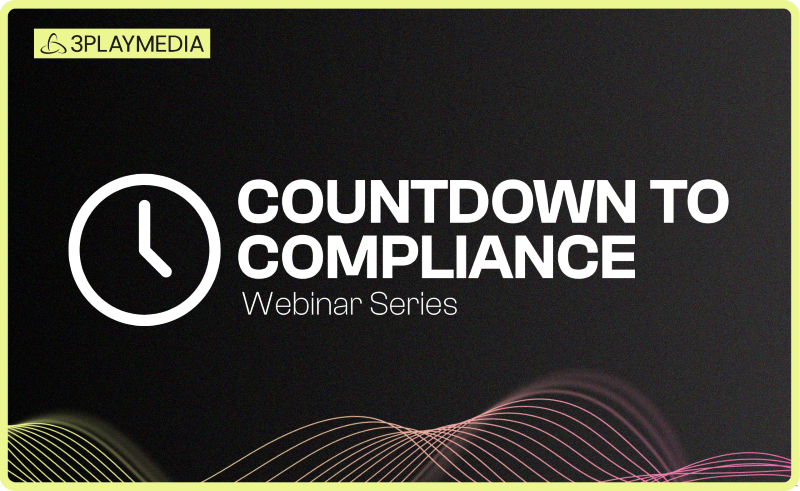- Accessibility
Disabilities Directly Impacted by Accessible Video
•

An accessible video should be perceivable, operable, understandable, and robust, according to Web Content Accessibility Guidelines (WCAG). Anyone, with or without a disability, should have access to interact and engage with video content. When barriers are present, it’s a recipe for inaccessible video, which leaves millions of people with disabilities excluded from watching content.
In regards to accessible video, captions may be the first thing that comes to mind. However, captions aren’t the only video feature needed to improve equal access.
In addition to captions, audio description, flash warnings, and accessible video platforms are necessary to create video content without barriers.
10 Tips for Making Web Video Accessible
How Accessible Video Impacts People with Disabilities
Accessible video impacts many people with disabilities, including those with ADHD, epilepsy, learning disabilities, and other disabilities. When creating video, it’s essential to practice universal and accessible design to ensure that everyone, regardless of disability, can watch video content safely, effectively, and without barriers. Asking people with disabilities about their needs is also a critical step in providing equal access and creating a more accessible world.
Attention Deficity Hyperactivity Disorder (ADHD)
According to the CDC, “ADHD is one of the most common neurodevelopmental disorders of childhood” and can often last into adulthood. The disorder causes several symptoms, some of which are difficulty listening, understanding, or remembering verbal information.
Captions may help those with ADHD as it can improve their focus on the content and the comprehension of information, as well as minimize any distractions.
Auditory Processing Disorder (APD)
People with auditory processing disorders may have trouble listening when background noise is present. According to Ohio State University’s Department of Speech and Hearing Science, they may also easily miss auditory information, have issues with the timing of auditory information, and struggle when people speak quickly.
For people with APD, captions can help combat background noise distractions and highlight relevant auditory information.
Autism Spectrum Disorder (ASD)
Autism spectrum disorder (ASD) is a developmental disability that can cause significant social, communication, and behavioral challenges (CDC). People with ASD may find it difficult to understand non-verbal communications, read others’ emotions, and process auditory information in cases where background noise is present or with multiple people speaking at once.
Captions and audio descriptions may help those with ASD because they can help emphasize human emotion and offer a different format of engagement, according to Judith Fellows, a researcher specializing in user experience, ethnography, and accessibility.
Audio description narrates the relevant visual information in video content. It highlights the emotion people display on-screen and reinforces the information through a secondary audio track. Captions offer a secondary visual element that identifies speakers, presents written dialogue and sound effects, and distinguishes relevant sounds from distracting background noise.
Tips for Creating Accessible Video
This white paper is designed to equip you with the knowledge and current best practices necessary to make your web videos accessible to all users.
Blind & Low Vision
Accessible video with audio description is helpful for people who are blind or low vision. Audio description tracks paint a picture of the visual elements occurring on-screen and narrates essential visual information, such as action, settings, facial expressions, costumes, and scene changes. It ensures that those who can’t see the screen don’t miss key visual elements.
Accessible video platforms will also ensure that people who are blind or low vision and who use a screen reader can navigate the application without difficulty.
Chronic Migraine
For some people with chronic migraines, light and other visual stimuli can trigger migraine attacks. Flickering or pulsing lights and repetitive patterns may potentially spark a painful migraine in some viewers. An accessible video should include flash warnings, as needed, to ensure people with chronic migraine syndrome can avoid any of these harmful triggers.
Deaf & Hard of Hearing
People who are deaf and hard of hearing need captions to ensure accessible video. Captions are time-synchronized text frames that display at the bottom of a video screen. They include dialogue, speaker labels, and non-speech elements and act as a supplement to or substitute for the audio.
Epilepsy
For about 3% of people with epilepsy, exposure to flashing lights at specific intensities or certain visual patterns can trigger seizures. This condition is known as photosensitive epilepsy.
It’s helpful to provide a flash warning if there are any strobing effects or flashing graphics to provide a more accessible video for those with epilepsy. Web Content Accessibility Guidelines (WCAG) 2.3 provides success criteria to reduce the risk of video triggering seizures. In general, creating videos with flashing should be avoided – there should be no more than three general flashes and no more than three red flashes within any one-second period. If the video does contain flashing, a warning should be issued initially, giving the viewer ample time to exit out of the video before being exposed.
Note: Independent Television Commission (ITC) also provides guidance regarding flashing, flickering, and regular patterns in media.
Learning Disabilities
In the US, nearly one in five children have a learning disability. Learning disabilities can include dyslexia, ADHD, and processing disorders.
Recent research indicates that captions are a useful learning tool – 75% of students in one study reported that they use captions as a learning aid. Several other studies also show that captions can help strengthen the reading skills of students with learning disabilities, including reading speed, fluency, word knowledge, vocabulary, and comprehension.
How to Make Web Video Accessible (White Paper)
Accessible video is essential and beneficial for many people with disabilities, and we recognize that the list above isn’t comprehensive. The best way to reach greater accessibility for all is to include people with disabilities in the discussion and to hear and honor their needs.
Everyone should have the opportunity to engage with and enjoy video content. Using video features like captions, audio description, flash warnings, and accessible video platforms is a start towards eliminating barriers and providing video content that is more universally accessible to everyone.
How do you utilize accessible video features? In what ways does accessible video help and benefit you? Share your experience in the comments below.
Filed under
About the author
Share this page
Related Posts
-
 Read more: Which Languages Are Required for EAA Compliance?
Read more: Which Languages Are Required for EAA Compliance?- Localization
Which Languages Are Required for EAA Compliance?
-
 Read more: Accessibility Laws for Public Colleges
Read more: Accessibility Laws for Public Colleges- Legislation & Compliance
Accessibility Laws for Public Colleges
-
 Read more: How to Create Audio Description for YouTube Videos
Read more: How to Create Audio Description for YouTube Videos- Audio Description
How to Create Audio Description for YouTube Videos


